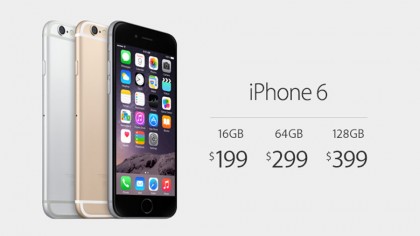10 things you need to know about the iPhone 6
Fitter, snappier, more productive
NFC may well prove to be the kickstart that the mobile payment ecosystem needed - or else a waste of time like Google Wallet. Only time will tell. Now, let's talk about health.
6. Health abilities
Apple's Health app will combine with the iPhone 6's advanced sensors and M8 coprocessor, as well as a whole bunch of third party apps and peripherals (and Apple's own wearables), to track and collate all of your health and fitness data.
You'll be able to check out your calorie intake, physical activity and more, all from the Health app.
The addition of Health and the Apple Watch, means that you won't necessarily take your iPhone out for a run with you anymore - which is perhaps good news given its increased size.
When you return from your runs, walks or hikes, your iPhone will be the hub to which you turn to for a summary of and contextual feedback on that data.
7. Camera upgrades
Apple has resisted boosting the megapixel count for the iPhone 6. The range hit 8MP back in the days of the iPhone 4S, and it's stuck with it ever since.
This is actually a good thing. Boosting the megapixel count alone doesn't necessarily mean an increase in image quality. In fact, with smartphone image sensors as small as they are, a high megapixel count can actually be detrimental.
Sign up for breaking news, reviews, opinion, top tech deals, and more.
Rather, Apple has improved the iPhone 6's camera in ways that really matter. There's a wider f/2.2 aperture for speedier, brighter shots, and Apple has dramatically improved the camera's image processing capabilities.

Once again the camera is 1.5 um pixels, despite claims that the iPhone 6 would have 1.75um pixels. This effects the amount of light getting into each picture, and thus the overall detail.
Apple has also implemented EIS, or Electronic Image Stabilisation, to reduce blurriness and improve low-light shots.
So you may be annoyed by the apparent necessity for a sticky-outy camera on your iPhone 6, but Apple has made darned sure that this minor aesthetic aberration will be worth it.
The front-facing selfie camera, or as Apple want you to call it, the FaceTime camera, has also been given some love. It's now a HD camera, with the same f/2.2 aperture and HDR FaceTime video support.
8. iOS 8
As we all knew it would, the iPhone 6 will ship with iOS 8, Apple's new mobile operating system. Announced back in June at WWDC, where it was shown off on the iPhone 5S, iOS 8 sees a whole bunch of improvements and general refinement added to the radical design overhaul that was iOS 7.
If iOS 7 was all about the aesthetics, iOS 8 concentrates on adding many of the features we thought iOS was missing - and quite a few that we didn't.
Besides the aforementioned Health app, iOS 8 will add interactive notifications, better interoperability with OS X, predictive typing, a new keyboard, superior gaming potential, and compatibility with the Apple Watch much more.

Yes, a lot of those new features appear to have been lifted straight from Android. But with Apple's customary attention to detail and tight integration between software and hardware, they could well prove to be better implemented here - and they'll be at their best on iPhone 6.
Naturally, iOS 8 has been optimised for the iPhone 6. Add in features like the one-handed mode, and you can see that Apple is aiming for a solid one-two hardware-software punch here.
9. Release date
The iPhone 6 will go on sale in key territories, including the UK and US, on Friday September 19. It will be available for pre-order from Friday September 12.

10. Price
Apple's pricing for its new iPhone starts from $199 for the 16GB version for a two year contract. The price then goes to $299 for the 64GB of storage and $399 for the 128GB model.
In the UK it's £539 for the 16GB iPhone 6, £619 for 64GB and a whopping £699 for the 128GB SIM-free model.
